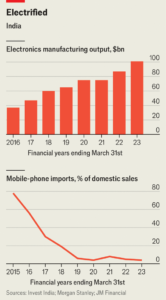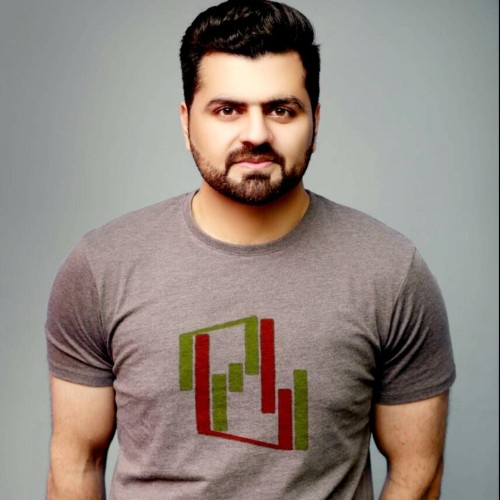
Your browser does not support the <audio> element.
Palmer Luckey owns six helicopters. He would like a seventh: a Chinook, the workhorse of Western armed forces. When your guest Schumpeter, meeting Mr Luckey in London, suggests that the British Army might sell him one, he laments that “eccentric US civilians” are low on the priority list of buyers. “I’ve been thinking,” he says, “I need to maybe hit up the Taliban.”
Mr Luckey, who co-founded Anduril, a defence-technology company, in 2017, is joking. Still, coming from a mulleted 31-year-old in a Hawaiian shirt and flip-flops, who made his fortune selling a virtual-reality company to Facebook and has now branched out into Game Boy replicas, it sounds plausible. Despite his eccentricities, Mr Luckey is not a man to be taken lightly. Anduril is now nipping at the heels of America’s biggest armsmakers.
A breakthrough came in April when the US Air Force awarded the firm a contract for the Collaborative Combat Aircraft (CCA) programme, which will eventually consist of more than 1,000 advanced drones supporting American fighter jets. For the Pentagon to hand a flagship programme to a startup, and to jettison the traditional prototype phase, is “extraordinary”, he says. The war in Ukraine has been a proving ground for these sorts of weapons—and for Mr Luckey’s company. He visited Kyiv two weeks into the war. “What we’ve been doing was tailored for exactly the type of fight that’s going on and exactly what we predicted was going to happen,” he argues, pointing to three lessons.
One is the importance of drones that can navigate and strike autonomously, even in the face of heavy jamming of their signals and obscurants like metal-filled smoke clouds. Many existing drones have struggled with this, says Mr Luckey, because they lack “multi-modal” sensors, such as optical and infrared cameras, to substitute for GPS, and do not have enough built-in computing power to use the latest object-recognition algorithms.
Second is the observation that software is eating the battlefield. Imagine that Russia begins using a new type of jammer. Mr Luckey says that the data can be sent back immediately to generate countermeasures, which are then remotely installed on weapons at the front line without having to change any hardware. A recent study by the Royal United Services Institute, a think-tank in London, noted that drones in Ukraine needed to have their software, sensors and radios updated every six to 12 weeks to remain viable. Anduril, claims Mr Luckey, is “literally pushing new updates…every single night”.
His third lesson from Ukraine is that weapons must be built in vast quantities—and therefore cheaply. He laments that Russia produces shells and missiles far more cheaply than America does: “The US is now on the wrong side of an issue that we were on the right side of during the cold war.” Anduril makes much of the fact that its production processes are modelled not on big aerospace firms, but automotive ones. Its head of manufacturing is a veteran of Toyota and Tesla, two carmakers. Its submarine drones are made using welded metal plates rather than a pressure vessel “because that can be made in something that looks a lot like a General Motors plant rather than a Lockheed Martin aircraft-assembly facility or a naval shipyard”.
For years defence-technology startups argued that the Pentagon’s byzantine procurement rules were rigged in favour of the big “prime” contractors. Anduril initially had to hire more lawyers and lobbyists than engineers, says Mr Luckey. The tide has now turned, he reckons, pointing to a flurry of defence contracts handed out to startups like Saronic, which makes naval drones. “At a very high level…there’s a belief that things can be done differently.” Investors increasingly agree. At its last funding round in December 2022, Anduril was valued at around $8.5bn. According to the Information, a news site, the firm hopes a new round will push that to $12.5bn. Still, that figure is only around a tenth of the value of Lockheed Martin, an industry giant. Mr Luckey notes that, besides Anduril, there have only been two defence “unicorns”, Palantir and SpaceX. More have made mattresses, he exaggerates.
The CCA contract is a huge boost, but it covers only the first, limited tranche of the project. Moreover, some Ukrainians grumble that software updates have been slow to arrive, leaving Anduril’s high-end Altius drones bamboozled by jamming, like other American offerings. Another person familiar with the firm’s products in Ukraine says that although the company’s software is impressive, its hardware is less so. Some in the Pentagon are keen to separate the two so that Anduril’s software can be plugged in more easily to competitors’ kit. For his part, Mr Luckey complains that America’s government retains a “caveman mentality” in which it will spend wodges of money on a high-tech product with remarkable built-in software, but will recoil in horror at the notion of paying far smaller sums for “just some code”.
Not droning on
Behind that frustration is a sense of urgency. Many defence bosses revert to euphemistic blather when asked about their products. Mr Luckey is one of the rare ones who embraces the fact that they exist to blow things up. He points to the slogan of one of his teams, “China 27”: products or features that are not ready for a conflict with America’s rival in 2027 are cast aside.
Mr Luckey’s vision of the future of war fuses two ideas: the centrality of technology and the need for vast numbers of weapons. “Fifty years from now the seas are going to be transparent. The skies are going to be transparent. We’re going to know where every sub is, every airplane is,” he says. “So then it’s a matter of: who’s going to make enough stuff to beat the other guy’s stuff.” America is not in a good place, he concludes. “We’re quite screwed.” Anduril, however, stands ready to help. ■
To stay on top of the biggest stories in business and technology, sign up to the Bottom Line, our weekly subscriber-only newsletter.

















